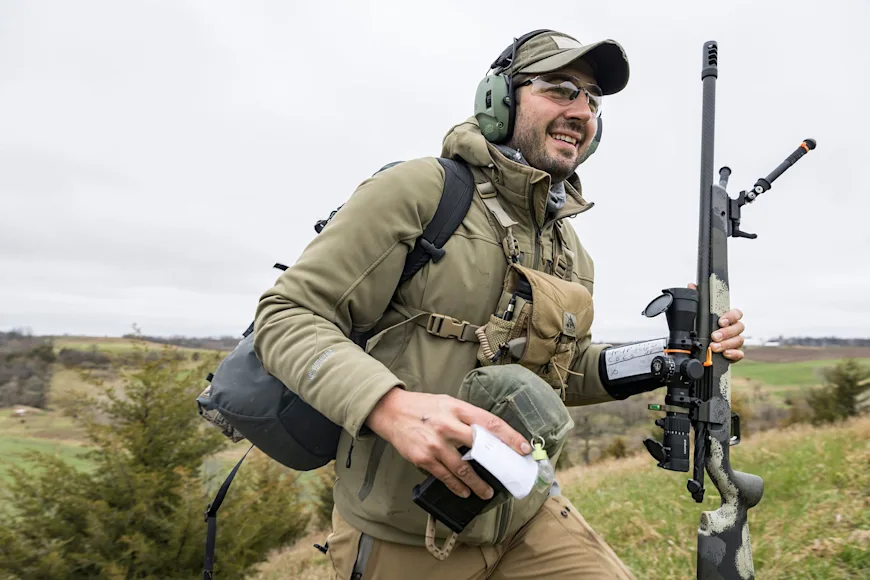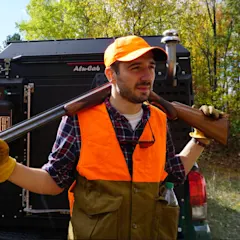_We may earn revenue from the products available on this page and participate in affiliate programs. Learn more ›
_
I PICKED A BAD TIME to learn how to shoot. At least, that’s what I think as I pack my gear for a long-range shooting class in Grand Junction, Colorado. I’ve been shooting rifles since I was 13, but a lot has changed since then—mainly the long-range craze. Like countless other hunters, I became interested in learning whether the math and science behind shooting at long distances could improve my skills in the field. I got started by competing in my first PRS match about a year ago and have been practicing ever since—but one thing is clear: I need more training.
My biggest problem right now, though, isn’t a lack of instruction. It’s a lack of ammo. Of all times to get serious about learning how to shoot, I do so in the midst of a countrywide ammunition shortage. I can’t find any to save my life.
Specifically, I’m looking for about 200 rounds of match-grade 6.5 Creedmoor. I bought some Berger Hybrid Match, but my rifle can’t group it tight enough for shots at distance. I call Chris Roberts, a shooting instructor who’s holding the class in Grand Junction, to see if it’s even worth going. “You should come anyway,” he says. “Let’s see what your rifle is doing when you get here. Worst case, I’ll lend you some ammo.”
When I meet Roberts three days later, he’s low-key and confident in a way you’d expect someone who can ring steel targets at over a mile would be. After serving in the Army for 18 years and working as a sniper school team leader and senior instructor, he helped open CR2 Shooting Solutions
to teach the general public. CR2’s three-day Mountain Rifleman course is geared toward taking long shots in adverse conditions. Along with instructor Chris Way, Roberts will teach us the effects of steep angles on ballistic data, how to make difficult wind calls, and how to pack our gear for shooting in rough terrain.

The author’s Springfield Model 2020 Waypoint in 6.5 Creedmoor. Here, it’s set up for competition with an Area 419 Hellfire muzzle brake, a Leupold Mark 5HD scope, and an Atlas bipod. Kathryn Gamble
Roberts rented out space for us at the Cameo Shooting and Education Complex. Set in rugged desert, the property is full of bermed 100-yard ranges for rifle and pistol shooting. There’s also an area with targets out to 2,000 yards and a 850-acre terrain park with randomly placed steel targets on cliff faces and sagebrush flats.
To a hunter from the East, a place like Cameo is shocking. I grew up shooting 100 yards at pie plates and pizza boxes at the local gun club. Since then, I’ve shot rifles out to a few hundred yards on hunting trips around the country—but I’ve never seen a shooting range like this. I’m ready to learn everything I can, but for now, all I can think about is my ammo. I bring it up to Roberts again, but he kind of shrugs it off and changes the subject.
Once it’s time to get started, Roberts asks us to shoot groups to see if we’re going to be able to keep up with the class—which I don’t think I’ll be able to because of my ammo. I start talking with Richard Davis, one of my classmates, who’s loading Hornady Match ammo into a magazine.
“I wish I could’ve found some of that stuff,” I say. “Nobody around me sells it, and my gun won’t group the Bergers I brought.”
Before Davis can answer, Roberts chimes in from the other end of the firing line. “Maybe it’s not the ammo,” he says. “Maybe it’s the shooter.”
Assume the Position
Wobble is the enemy of any rifle shooter. In a nutshell, this is what instructor Chris Way is trying to explain to us after we finish zeroing our rifles. Way spends his time figuring out how a shooter and a rifle get along—a problem he’s trying to solve with cold, hard data. His goal is to minimize the micromovements a shooter imparts on a rifle and to maximize consistent accuracy on target. To do this, he’s come up with a drill and a program to diagnose a shooter’s problems based on the evidence they leave on target.
Way’s program is called Rifle
, and his drill is the Kraft Drill, which consists of 12 shots from four positions—standing, seated, kneeling, and prone—at one target 100 yards away. Way lines up a series of tripods at various heights for each position. If our shooting positions are sound, each of our 12 shots will group at 1 to 2 MOA, or 1 to 2 inches at 100 yards. It sounds simple. It sounds easy. Shortly after our group of seven shooters runs the Kraft Drill, however, we all hate it.

Match director Jim See briefs a room full of long-range shooters before an NRL Hunter match in Decorah, Iowa. Kathryn Gamble
In 12 shots, any delusions you may have about being a good rifle shot are gone. As each class member runs the Kraft Drill, we see them shaking their heads or trying to laugh off a bad hit. Even though we’re running some of the best rifles and optics available, none of us can get a 100-yard group under 5 inches.
But that doesn’t mean we’ve failed the drill. Each of our group sizes is now that participant’s “shooter bracket”—a baseline that tells us how far we can ethically shoot in the field and a place from which to improve. Based on our groups, Way can mathematically predict that most of us have no business taking shots at a deer’s vitals past 200 yards because of variables like wind and stress. This hits home for everybody in the class. Before, most of us based our maximum range on our rifle’s capability, ballistic coefficients, and successful shots we’d made in the past. Based on our Kraft targets, there may have been a bit more luck involved than we’d like to admit.
Back in my hotel room that night, I uncase my rifle, confirm it’s unloaded, and set it up on my tripod in the standing position for the Kraft Drill. I focus the reticle on a dead fly smashed to the wall. The harder I try to steady the rifle, the more it bobs and weaves in a figure-eight pattern while I hug the buttstock tightly and put downward pressure on the fore-end with my support hand.
Then it all clicks.
I do the opposite, letting off pressure on the comb, and, as Way showed me, I bring my support hand inward and hold the scope ring instead of the fore-end. This lets me position my shoulders squarely behind the rifle, and the crosshairs stop moving. No matter how much I breathe, the reticle stays put, hovering around the fly in a tight 1-mil circle.
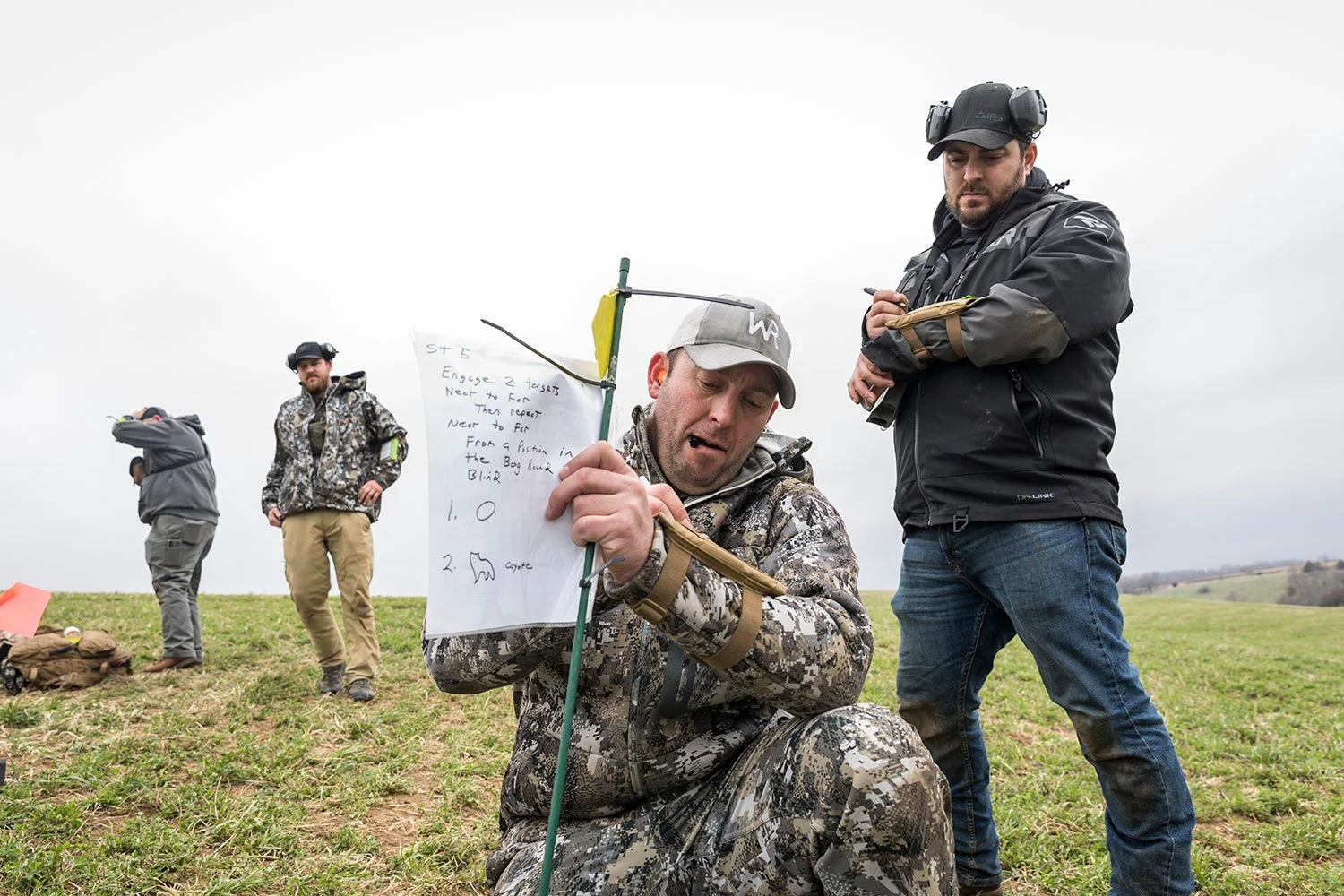
Competitors in NRL Hunter matches don’t know where targets will be placed for each stage. Instead, posted signs give a rough idea of how many targets to look for and what positions a shooter needs to take. Kathryn Gamble
Over the next two days, Way and Roberts work with us in the field and in the classroom. We take our skills to the terrain park, where we find, range, and shoot targets out to 1,000 yards, making real-life wind calls that either work or don’t. On the last day, we all end up back at the 100-yard range for one more Kraft Drill.
On the firing line, I take the same position I did in the hotel, adding and letting off pressure until the reticle settles as much as possible. I keep my point of aim within the smallest diamond on the Kraft target and pull the trigger, placing a shot ¼ inch left of center. It’s a good shot, but it doesn’t mean anything until I get another one or two on paper. I move to the kneeling position and repeat my process, finding a balancing point with the rifle and settling to my original point of aim. The rifle punches me in the chest, and my shot hits right next to the last one.
No matter what position I get in, I decide not to shoot until I’m as settled as I was for my first two shots. Every shot I make seems only to enlarge the hole in the center of the paper. That is, until I shoot two fliers. But I predict each of them because of a bad position or a flinch. When we walk downrange, I read my shooter bracket. Roberts was right. It wasn’t the ammo, it was the shooter.
The thing is, building a good shooting position is only part of the equation. I still have a long way to go. But I feel ready for the next challenge.
Putting It All Together
It’s going to rain in Iowa. At least, that’s what the meteorologist on my truck’s radio says as I drive west from Wisconsin. I’m heading to Decorah for a three-day NRL Hunter
match. Until now, I pictured shooting the match in short sleeves and sunblock. But the 20 mph winds and 30 mph gusts have me thinking about more than just what to wear. This’ll be the strongest wind I’ve shot in so far.
At Roberts’ class in Colorado, a classmate told me about NRL Hunter, and it seemed like the perfect place to test what I’d learned so far. The PRS match I shot nearly a year ago was all about speed. That’s a big reason heavy PRS rifles are often referred to as race guns. NRL Hunter matches are different. They’re shot with equipment similar to what a hunter would use, and the stages are structured to simulate finding and shooting game animals.
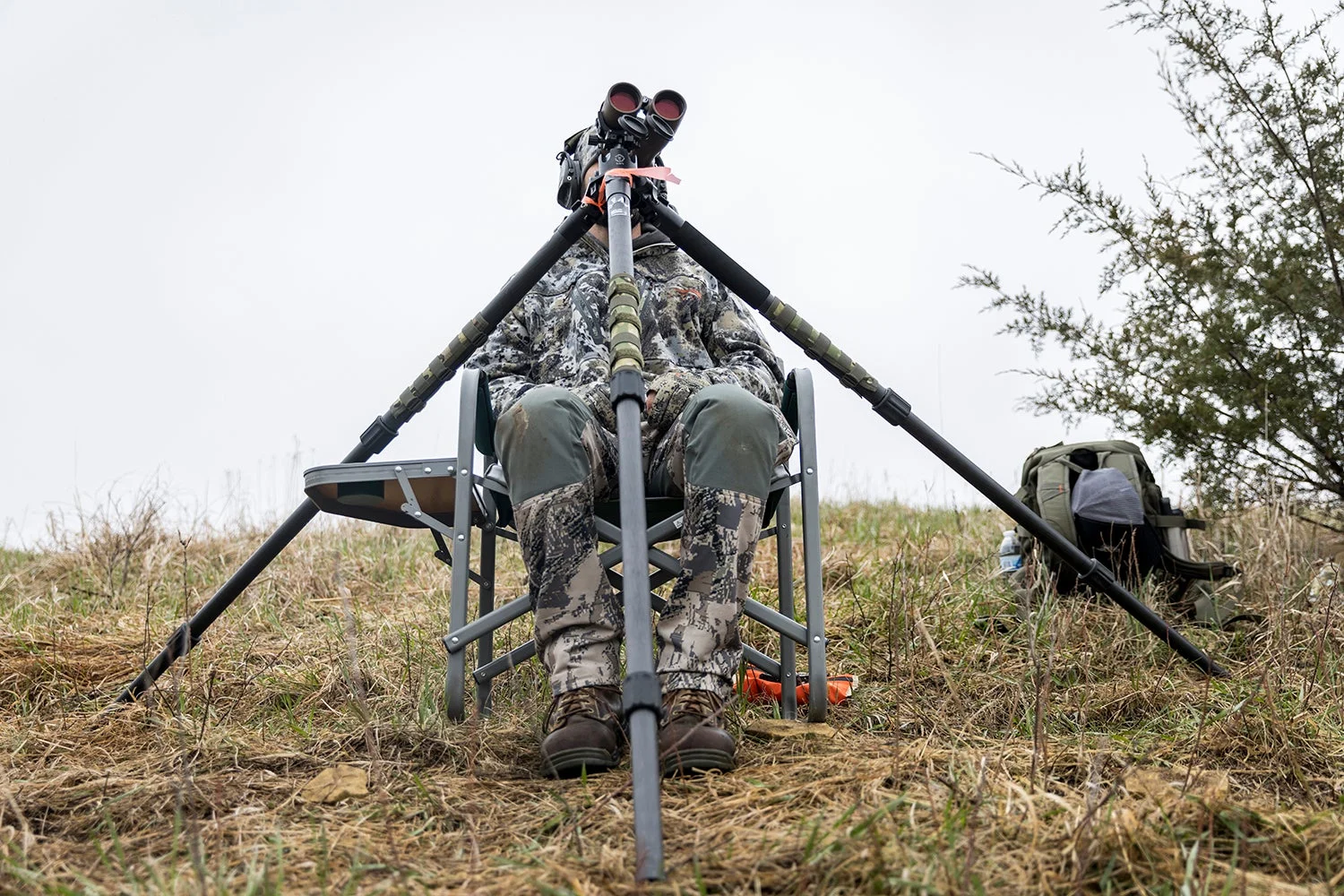
A range officer watches and keeps score for a shooter. In NRL Hunter, range officers are like referees, but they can answer only yes or no questions, or call “impact” when a shooter hits their target. Kathryn Gamble
Rifles need to be under 12 pounds for most NRL Hunter divisions, and cartridges need to meet a certain power factor. While 12 pounds sounds heavy for a hunting rifle, it restricts the use of purpose-built race guns. The stages are different too. Instead of knowing where all the targets are, NRL Hunter competitors navigate a course of blind stages. They have four minutes to find, range, and shoot targets at random distances. All the kill-zone-size targets are painted black or put up next to animal silhouettes for added realism. Shooters need to connect with them in two shots, or they don’t get any points. And short of lightning strikes or tornadoes, NRL Hunter matches don’t get rained out.
I meet Travis Ishida, co-founder and president of the NRL, at a lodge that was leased for the competition. Ishida, 43, is from California. In 2021, he started the NRL Hunter series with Scott Saterlee so hunters could test their gear and shoot in practical situations.
Ishida immediately sizes up what I’ve brought for the match and says I could use a few upgrades. We head to his truck, a jacked-up diesel Ram with California plates. He pops open the tailgate and pulls out a long drawer filled with ammo and long-range shooting equipment and starts filling up my backpack. Ishida knows better than most that shooters need the right stuff to compete, and he doesn’t want money to be a barrier to entry for an NRL Hunter event. That’s why he travels around with all this stuff.
NRL members can ask him for a piece of gear like the ones I just borrowed or a complete load-out for a match, including a rifle and high-dollar items like rangefinding binoculars. He’ll even sell NRL members cases of ammo at cost.
“NRL Hunter has always been about education,” Ishida says. “It’s a competition, but we want to help hunters become better, more ethical shooters in the field.”
Out of Time
The match kicks off with a shooters’ meeting before I, and about 100 other shooters, head into the field. I start making hits out of the gate, but a few stages in, I see the tricky thing is going to be finding the targets. I’ve brought a set of rangefinding binoculars to lessen the time it takes to find and range a target, but if I spend too much time glassing, I have less time to shoot.
“If you can find three targets and you’re coming up on two minutes, just start shooting,” says Morgan Vetter, one of my squad-mates. It’s against the rules for me to watch him while he’s running the stage, but from the sound of pinging steel and consistent “Impact!” calls from the range officers, I can gather from the sidelines that he’s done this before. Vetter is from Sioux Falls, South Dakota, and we’re competing against each other. But there’s a sense of learning together at these matches, and I’m picking up on things I can actually use as a hunter.

The author takes aim from a fallen tree limb. Lightweight shooting bags like the one shown from Armageddon Gear go a long way toward steadying a rifle in the field. Kathryn Gamble
Around noon, I get into a rhythm. I know the rules, I know what I need to do when I get to a stage, and I can just shoot. But it still isn’t easy—and my score is reflecting that. Shooting on the clock brings a level of stress and disorientation that’s still new to me. I’ve never suffered from buck fever much; I usually get the adrenaline dump and jitters after I pull the trigger. But the timer gives me a kind of tunnel vision that exposes my weaknesses. I’ll build a position where I can’t see the target, or I’ll overcomplicate things. Worse yet, I’ll take up an unsteady position and go for a shot anyway, knowing full well that if I hit, I’m just getting lucky.
With only a few stages to go on the first day, I try to slow things down. I remember what Ishida said about learning and about what I want to get out of this weekend. This isn’t about winning, it’s more about getting better as a hunter, and trying to beat the clock isn’t going to help me come fall when I’m faced with the real thing. I settle on a goal similar to the one I had for my PRS match: good single-round hits on one target at a time. With that in mind, I start to see what I’m doing wrong and remember the things I learned in Colorado. I make some hits but take more time trying to get better. Stage by stage, I do.
Clean Break
With more than half the match over, I’m mentally drained. So far, it’s been like practicing the moment of truth for dozens of hunts in a matter of hours. I’m learning my limits as a hunter, something that would otherwise take years and a lot of bad shots at deer to find out. But before it’s all over, I still want to clean a stage.
For NRL Hunter that means four first-shot hits for a perfect score of eight points. And with the wind blowing through the valley in front of me, that also means four perfect wind calls. For the last six stages, it’s all I care about. If I can find a target, I focus on the wind call and nothing else. I pay attention to when the wind gusts and what it’s doing when I’m not shooting, and I constantly stay abreast of the wind speed. Just before shooting the second-to-last stage of the day, I feel like it’s all coming together.
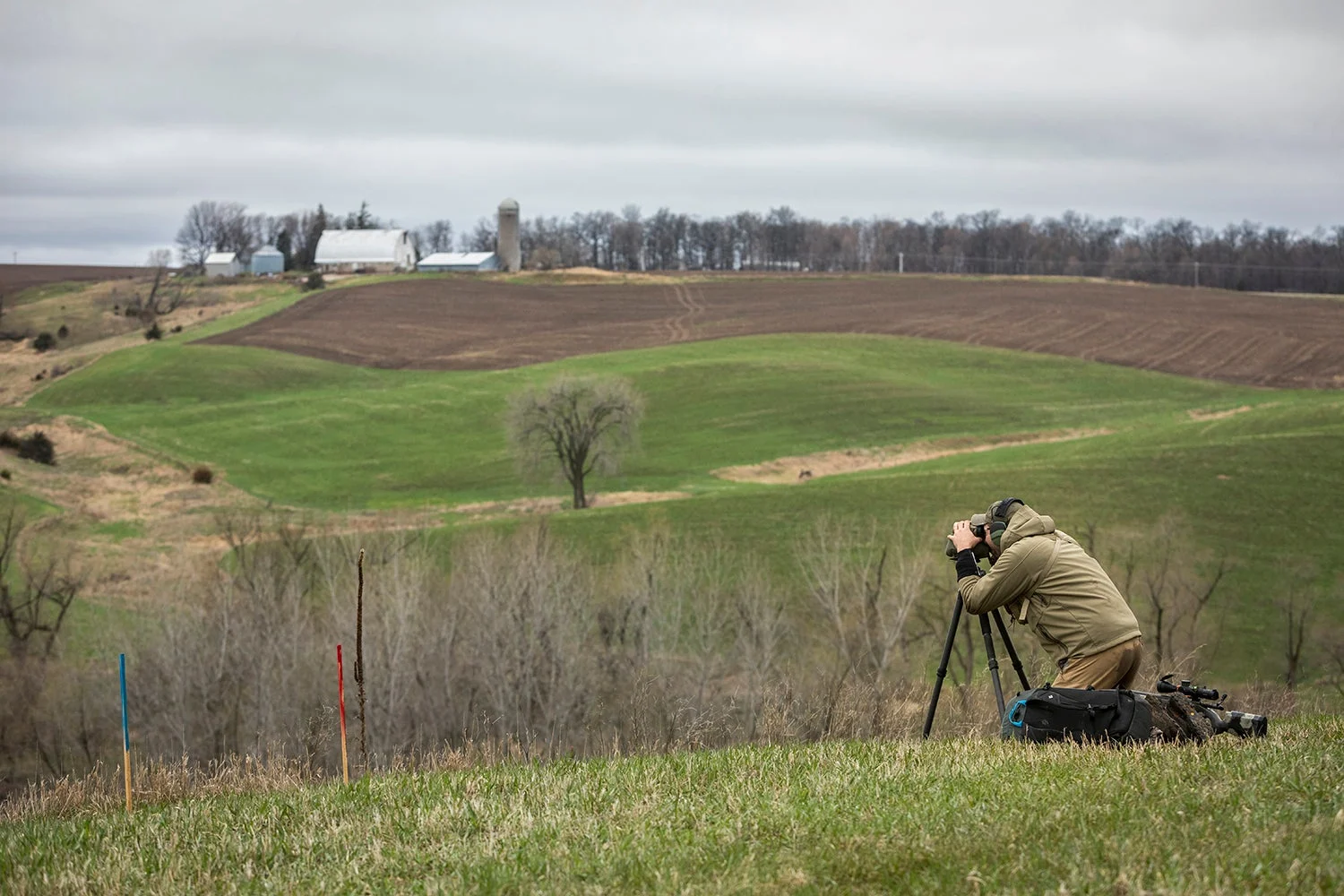
Along with finding targets, NRL Hunter competitors need to range them, too. Many shooters use rangefinding binoculars to save time and keep track of targets. Kathryn Gamble
The course of fire calls for four hits on one target from four positions. The target is a deer-shaped silhouette the size of a deer’s vital zone. The range officer asks me if I understand this, and I reply in the affirmative. He starts the clock and I run for the first position.
I’m so focused on making the shot that when I find the target I don’t even bother to look at the range—just the holdover of 1.8 mils. With the wind blowing around 10 mph at 2 o’clock, I decide to hold just off the right edge of the plate. I take my binocular from the shooting bag on my tripod and pick my rifle up from the ground. I load the magazine but fail to seat it properly. When I get on target, it falls out into the mud. Slow down, I think as I clean dirt from the magazine and slap it back into the rifle.
I look for the target again in my scope, working the magnification back and forth. I end up in a crouched position halfway between kneeling and sitting with my rifle on the tripod and my shooting arm resting on my knee. I think about my shot process, square up to the rifle, and watch the reticle dance in a tight circle at the edge of the plate. If my wind call is good, I know I’m going to hit this target.
“Impact!” the range officer shouts.
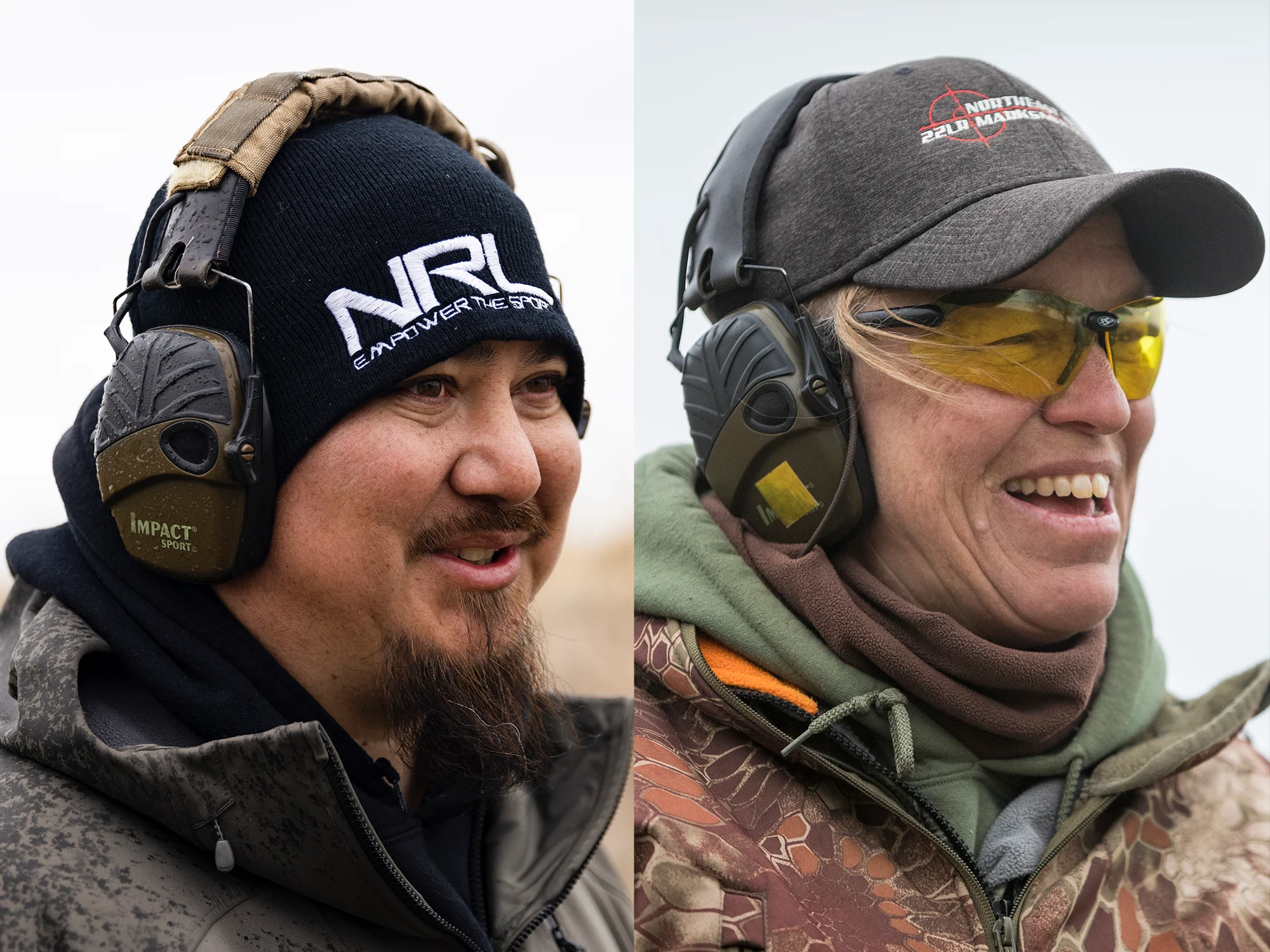
From left: NRL co-founder and president, Travis Ishida; NRL Hunter range officer Terri Webb. Kathryn Gamble
I pick up the tripod and move to the next position, marked by a blaze-orange tomato stake driven into the ground. I look for the target while I crouch again and find the touch points for my rifle, elbow, knee, cheek, and support hand. I rack another round and pull the trigger.
“Impact!”
The third position goes just like the first two. I repeat the same motions and find the same target.
“Impact!”
I turn to run to position four and can’t believe I still have time on the clock. When I get there, I see the same tomato stake in the ground, but it’s next to a tree with a limb sticking out at chest level. I could easily take the crouching position that’s worked for three consecutive shots, but the hunter in me only sees the limb. It’s what I look for to steady myself when I see a deer, a squirrel, or a rabbit. I can’t help myself. I cast the tripod aside and throw my shooting bag over the limb. I must be out of time, I think while I get ready for a standing shot. There’s no way I’ll get steady here, I think as I work the magnification on my scope.
I fall back into the routine I practiced at the hotel room in Grand Junction, adding and subtracting pressure until the crosshairs hover on the right edge of the target. The last two pressure points I add are my thumb over the grip and a slow pull with my trigger finger.
“Impact!”
I watch the little steel deer jump and sway on the target hanger. There’s no tag to punch or meat to pack out, but I beat the clock. Even better, I’m ready for the real thing this fall.
_This story originally ran in the Limits Issue
of_ Field & Stream_. Read more F&S+
stories._

